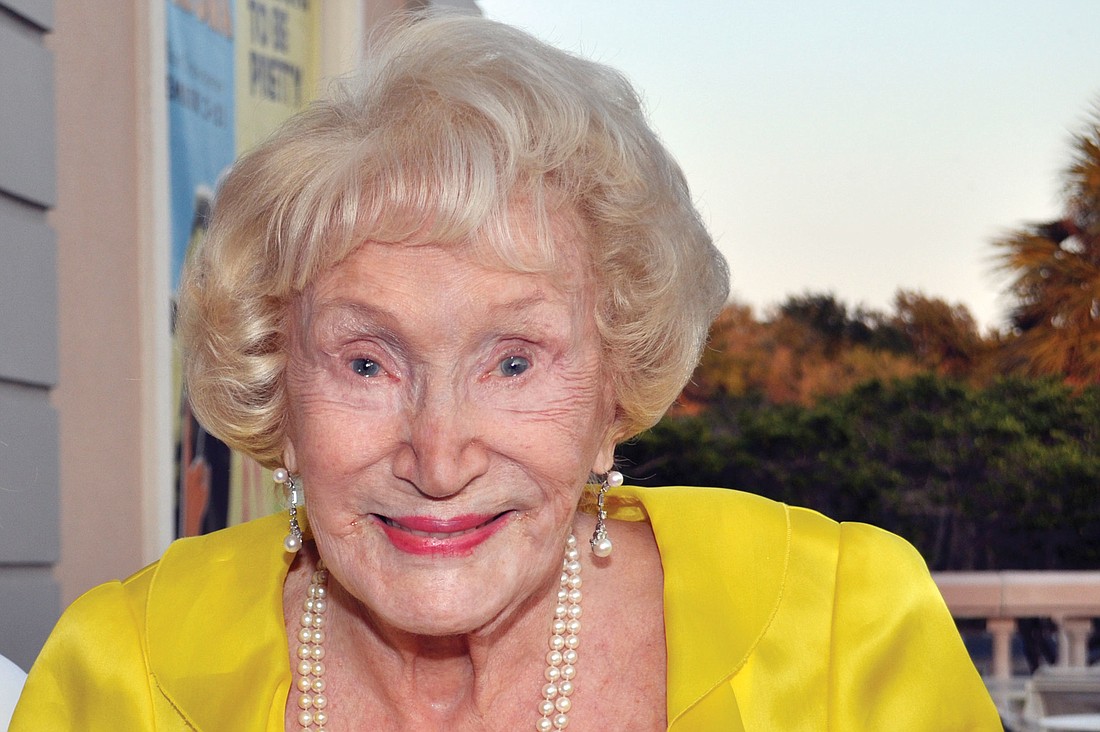- April 25, 2024
-
-
Loading

Loading

Grande is …
The concept of a “grande dame,” with an extravagant, passionate, even theatrical personal style, may be somewhat antiquated, displaced in contemporary society by the image of a powerful female executive. It was, nonetheless, vividly recalled by the recent centennial of a Sarasota icon, philanthropist and arts-lover Ulla Searing.
Searing wanted to celebrate her 100th birthday and came darn close to doing it. She died of old age June 28, at her home at Tessera. The co-trustees and executors of her estate, Jennie Famiglio and John Mason, decided to have a party, anyhow, on her actual birthday, Oct. 21.
As observed in the “Black Tie & Tales” column last week, the reception was just as Searing would have wanted it: the “correct” place, people, music and food. Guests went home with a prettily packaged souvenir of her favorite marzipan fruits.
One treat was, somewhat inexplicably, missing; East Hampton friend Mark Fabry spoke of “the profound silence that would manifest when she had … chocolate. She was that simple.”
It is unlikely that Sarasota would have used that adjective but Fabry is a credible authority; he “inherited” Searing 30 years ago from an uncle who was her close friend. Fabry describes their time together as mostly “one on one” and said, “Simplicity, elegance, strength and gentleness concurrent with a fierce Viking nature. She set such a standard for me and I hope I can be that for others.”
That Viking nature was also recalled by Searing’s long-time friend, Tana Sandefur, who told her favorite Ulla story: “Ulla told me, ‘I just caned somebody in the elevator because I didn’t like him and I’m a Viking and I can get away with it.’”
Searing wrote her autobiography at age 97. Famiglio and Mason and their respective partners, Mark Famiglio and Scott George, read it at the reception. Along with several photo albums, it reveals much about Sarasota’s “grande dame” that is less well-known than her impressive philanthropy.
Searing’s standards of manners and social correctness rather belie her somewhat surprising beginnings. She was the illegitimate daughter of a Swedish aristocrat who became pregnant by her fiancé. And this was not the first scandal in the family, which was related to the famed Liljevalchs clan. Searing writes that her grandmother was the first divorced woman in Stockholm, so embarrassing her mother (Searing’s great-grandmother) that “she drove around in her carriage with the blinds drawn.”
Dr. Herman Rosengren, who tended her mother, adopted Searing, who noted, “I always wondered who was my mother … the servants and other people gossiped, too, and, eventually, I figured out who my mother was. When I was 12, my adoptive father told her she had to tell me. I knew it all along, but never said anything.”
According to her first cousin once removed, Jeremy Ingpen, who spoke at her reception, when others observed a resemblance between mother and daughter, Searing’s mother actually denied any relationship.
As painful, though, this clearly was, Searing relished her summer visits to the family she did have — cousins in the south of Sweden.
After the crash of 1929 and the death of Dr. Rosengren in 1932, Searing left Sweden for the care of her wealthy grandmother in Surrey, England. She came to the United States in 1946, according to a naturalization certificate, and became a career girl.
“I worked at the consulate for a while and I worked for a Swedish importer,” she wrote. “Also, at that time, I was teaching Swedish in the Berlitz School of International Languages in New York. I was very fortunate to get a very good apartment (a walk-up) in a very desirable area on Madison Avenue and 55th Street.”
Searing met Arthur Searing, the finance vice president of AIG, who had an invalid wife, in 1956, and they wed in 1963. She writes, “We were married in the Searing Church in Searingtown on Long Island. We had a house in Southampton and belonged to clubs there. We played a lot of golf, and on one lucky day I won a ladies golf tournament. We traveled an awful lot abroad, once around the world on the QEII.”
When Arthur Searing retired in 1973, they began spending winters on Longboat Key, and when he died in 1983, she moved into Sarasota. According to the autobiography: “I had two marriages after Arthur, one to a Dane who had Alzheimer’s. That was a very short marriage … Then, I married a very interesting French-Canadian man who was very smart.” That marriage to Claude DuPont was in 1998. Searing came to fear that DuPont would hurt her and at one point decamped with one of her helpers to The Colony, registering under an assumed name; she divorced him in 2004.
Throughout her colorful-to-say-the-least life, Searing was a passionate lover of the arts and it is this for which she is most remembered in Sarasota. She was also a fiercely loyal friend. Note this excerpt from a letter she wrote to The Observer about her 2006 donation to New College: “I want to emphasize the fact that the reason I gave the donation to New College was that my late husband, Arthur Searing, and I always wanted to honor Gen. Rolland Heiser for the extraordinary work he has done for the college.”
How well that fits with Jennie Famiglio’s comment at Searing’s posthumous party: “Despite a 60-year age difference, she was a great girlfriend: strong, formal, playful, refined and focused.”